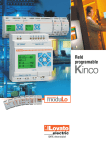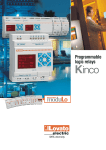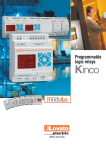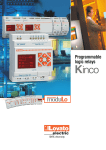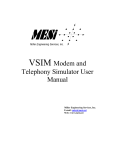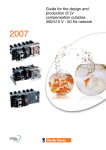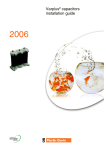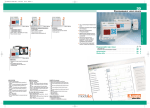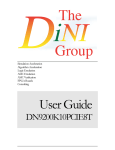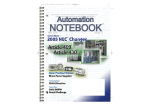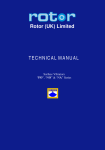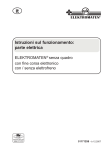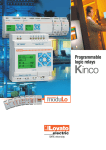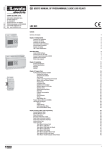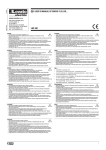Download The direct current braking block USER MANUAL 1. Use
Transcript
The direct current braking block DCBB 16, DCBB 63, DCBB 80 1. USER MANUAL Use, characteristic The direct current braking block DCBB is designated for the braking of asynchronous motors by direct current. The braking is performed in to two phases of the motor by a current from a one way rectifier with a zero diode, both of the diodes are protected by RC members against the effects of the voltage spikes. The DCBB when connected according to the enclosure, or in a similar connection securing the maintaining of technical parameters, ensures the shortening of the rundown period of the motors following the instruction for stopping. The amount of the braking current, which means the braking intensity, is given by the impedance of the motor’s winding, and it can be affected by the connection method and the amount of the supply voltage. The time of the effect of the braking current is set during the putting into operation by a time relay, for the necessary period for putting the motor into a calm state, so that the motor is not unnecessarily loaded by the braking current. According to the application method, the braking period ranges between about 2 to 10s. Special applications, for example a higher frequency of breaking than is stated in the technical information, has to be agreed upon with the manufacturer. 2. Construction design The DCBB 16 is designed to be mounted into distribution boards while being attached to the normalized installation strips of profiles EN 50035 ( TS 32 ) and EN 50022 ( TS 35 ). DCBB 63, DCBB 80 only for the strip EN 50022 (TS35) The brake circuits are built in to the plastic cover. The removal of the heat loss is secured by a cooler on the top of the cover. The terminals DCBB16 allow the connecting of one wire up to a cross-section of 2.5 mm 2 . The terminals DCBB 63, DCBB 80 allow the connecting of one wire up to a cross-section of 6mm 2 . 3. Technical parameters Type Operational voltage Average value of the braking DC current Period and frequency of braking Operational environment Operational temperature Protection Dimensions Weight 11/2011 DCBB16 max. 400V AC max. 16A DCBB63 max. 500V AC max. 63A DCBB80 max. 500V AC max. 80A about 2 ÷ 10 s, max 30 cycles / hour ambient temperature –10 to +50 °C, relevant humidity max. 80% arbitrary IP20 79 x 96 x 81 mm 110 x 110 x 123 mm 0.35 kg 0.86 kg page: 1 pages: 2 The direct current braking block DCBB 16, DCBB 63, DCBB 80 4. USER MANUAL Related norms ČSN EN 60146-1-1 „Semiconductor converters - general requirements for converters with network commutation“ ČSN EN 60204-1 „Machine equipment safety - Electrical devices of machines“ 5. Installation, operation and maintenance The installation of the DCBB must correspond to the valid norms and regulations, primarily it has to correspond to the norm ČSN 60204-1. The evaluation of the concordance of the device, before being introduced to the market or in to operation for the entire system, including the DCBB and the method of its electrical installation, is the responsibility of the customer of the product. The product does not contain high-frequency circuits – sources of interference and due to the reason of its utilization in a machine’s electrical installation, it is not necessary to perform any further verification of concordance with regards to the EMC. The DCBB do not require any special operation or maintenance. 6. Packing, transportation and storage The DCBB are delivered packed in a carton box. The transportation of the DCBB is done by regular transportation means. During transportation, the DCBB must be secured in such a way, so that they do not get damaged. It is possible to store the DCBB in areas protected against undesired effects, with an ambient temperature of –10 to +50ºC with a relative humidity of max. 80%. 7. Disposal During the operation or the disposal of the device, it is necessary to maintain the relevant national regulations about the environment and the disposal of waste. In the case that the device has to be scrapped, it is necessary during its scrapping to proceed according to separated disposal, which means to respect the difference of materials and their composition (for example metals, plastics, etc.) During separated disposal, it is necessary to refer to specialized companies, who perform the collection of these materials and at the same time respect the valid local norms and regulations. Enclosure no. 1 - Examples of application of the DCBB16, 63, 80 in vibrating technology Enclosure no. 2 - Table of values for 1 motor Enclosure no. 3 - Table of values for a pair of motors Processed by: Pavel Pech 11/2011 page: 2 pages: 2 Apendix 2 – Instructions for use of DCBB 1 motor 3x400V M1 FO12/6 NO02-515,805,1090 NO12 NO16 NO14 NO28 NO22 NO26 NO38 NO24 NO36 NO32 NO34 NA36 FU1 [A gG] 2 FU2 [A gG] 4 FA1 LRD03 0,25-0,40A KM1 LC1D09 KM2 LC1D09 GU1 BSB16 2 4 LC1D09 LC1D09 BSB16 4 6 LRD04 0,40-0,63A LRD05 0,63-1A LC1D09 LC1D09 BSB16 4 8 LC1D09 LC1D09 BSB16 6 8 LC1D09 LC1D09 BSB16 10 10 LC1D09 LC1D12 BSB16 NA32 NA34 NA44 NA46 NA54 NA56 NA64 16 16 LRD06 1-1,7A LRD07 1,6-2,5A LRD08 2,5-4A LRD10 4-6A LC1D09 LC1D18 BSB63 20 25 LC1D09 LC1D18 BSB63 20 40 LC1D12 LC1D32 BSB80 NA66 25 40 LRD12 5,5-8A LRD14 7-10A LRD16 9-13A LC1D18 LC1D40 BSB80 FU1 [A gG] 2 FU2 [A gG] 4 KM1 LC1D09 KM2 LC1D09 GU1 BSB63 2 4 FA1 LRD02 0,16-0,25A LRD03 0,25-0,40A LC1D09 LC1D09 BSB63 4 6 LRD05 0,63-1A LC1D09 LC1D12 BSB63 4 8 LRD06 1-1,7A LC1D09 LC1D12 BSB63 6 8 LC1D09 LC1D18 BSB63 10 10 LC1D09 LC1D18 BSB63 16 16 LRD07 1,6-2,5A LRD08 2,5-4A LRD10 4-6A LC1D09 LC1D32 BSB63 20 40 LC1D12 LC1D40 BSB80 25 40 LRD14 7-10A LRD16 9-13A LC1D18 LC1D50 BSB80 1 motor 3x500V M1 NO02-515,805,1090 NO16 FO12/6 NO12 NO14 NO28 FO22/6 NO22 NO24 NO26 NO32 NO34 NO36 NA36 NO34 NA32 NA34 NA44 NA46 NA54 NA56 NA64 NA66 Apendix 3 – Instructions for use of DCBB 2 motors 3x400V M1,M2 FO12/6 NO02-515,805,1090 NO12 NO16 NO14 NO28 NO22 NO26 NO38 NO24 NO36 NO32 NO34 NA36 FU1 [A gG] 4 FU2 [A gG] 4 FA1,FA2 LRD03 0,25-0,40A KM1,KM2 LC1D09 KM3 LC1D09 GU1 BSB16 4 4 LC1D09 LC1D09 BSB16 4 4 LRD04 0,40-0,63A LRD05 0,63-1A LC1D09 LC1D09 BSB16 6 6 LC1D09 LC1D09 BSB16 8 8 LC1D09 LC1D09 BSB16 12 10 LC1D09 LC1D12 BSB16 NA32 NA34 NA44 NA46 NA54 NA56 NA64 20 12 LRD06 1-1,7A LRD07 1,6-2,5A LRD08 2,5-4A LRD10 4-6A LC1D09 LC1D18 BSB63 25 12 LC1D09 LC1D18 BSB63 32 20 LC1D12 LC1D25 BSB63 NA66 32 20 LRD12 5,5-8A LRD14 7-10A LRD16 9-13A LC1D18 LC1D25 BSB63 FU1 [A gG] 2 FU2 [A gG] 4 KM1,KM2 LC1D09 KM2 LC1D09 GU1 BSB63 4 4 FA1,FA2 LRD02 0,16-0,25A LRD03 0,25-0,40A LC1D09 LC1D09 BSB63 4 4 LRD05 0,63-1A LC1D09 LC1D09 BSB63 6 8 LRD06 1-1,7A LC1D09 LC1D12 BSB63 8 8 LC1D09 LC1D18 BSB63 12 10 LC1D09 LC1D18 BSB63 20 16 LRD07 1,6-2,5A LRD08 2,5-4A LRD10 4-6A LC1D09 LC1D25 BSB63 32 20 LC1D12 LC1D40 BSB63 32 20 LRD14 7-10A LRD16 9-13A LC1D18 LC1D40 BSB63 2 motors 3x500V M1,M2 NO02-515,805,1090 NO16 FO12/6 NO12 NO14 NO28 FO22/6 NO22 NO24 NO26 NO32 NO34 NO36 NA36 NO34 NA32 NA34 NA44 NA46 NA54 NA56 NA64 NA66





